



Think of us as your guest home.









































We may be celebrating our 10th anniversary of Emporia Living, but we are also celebrating a new beginning here at The Emporia Gazette. Over the last year, we’ve been in the process of moving into our new location at 109 W. 6th Avenue. It may not have the grandeur of 517 Merchant, where the Gazette was housed for over 120 years, but our new space fits us perfectly and we are excited to finally be settled.
Much like the newspaper itself, our new home is a great mix of the old and the new.
We remodeled the office and worked to combine some of the best journalism office elements from our old office into our new home with a modern look and feel.
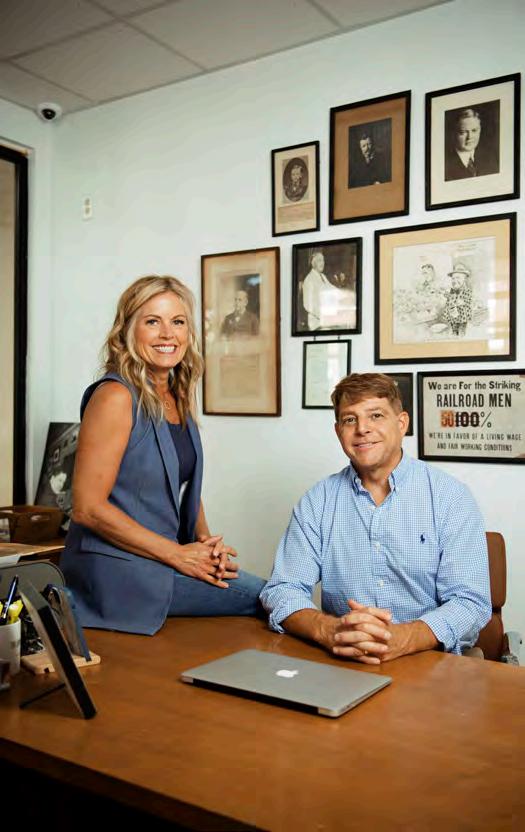
From our original antique reporter desks and historic pictures showcasing the importance of our place in journalism history to modern design elements, like sliding glass walls and windows, the space suits us well.
We do have a couple of favorite features in the new space that deserve some special attention:
One is William Allen White’s original Emporia Gazette sign that hung outside the original Gazette building. It spans exactly 15 feet and it was one piece we were not sure we would have a place for in the new office. However, after much speculation and careful measuring the sign fit on the wall above our front desk with only a quarter of an inch to spare. We all took it as a “sign” that the space was, indeed, the perfect fit for us.
Another favorite feature in our new space is the floor-to-ceiling mural that hangs in our new newsroom. It is a black and white photograph from 1921 of a busy newsroom filled with reporters, editors, and dozens of Royal typewriters. Covering the entire west wall of the newsroom it is a daily reminder us that long before us there were dedicated journalists covering the news and issues of the day and long after us there will be more to do the same.
As we continue to get settled in we look forward to keep telling our community stories for you for generations to come. We welcome everyone to stop in for a visit and if you cant stop in you can view some images of our new office on pages 62 and 63.
 Chris Walker Editor and Publisher
Ashley Walker Editor
Chris Walker Editor and Publisher
Ashley Walker Editor






At 14 years old, Maddox “Ox” Shively is not only doing his part to protect one of the most vulnerable creatures alive but creating a thriving business at the same time.

The sight of over 140,000 honey bees would send most people running for their lives, but for one Emporia boy, the massive swarm of insects is just a sign of sweet success.
Fourteen-year-old Maddox Shively is a beekeeper. Not a typical first job for most kids, but then again, Maddox (“Ox”), isn’t your typical kid.

It all started in third grade.
“I read in Time for Kids that bees were endangered,” he said. “And I wanted to fix that.”
So, with all the optimism and enthusiasm of an 8-year-old, he came home from school that day and told his parents that he was going to be a beekeeper.
“They thought I was crazy…. that it was just a phase,” he said.
But it certainly wasn’t a phase. Not long after the plight of the honey bee gripped his heart, Ox started making plans to do something about it. He applied for a scholarship through the NEKB (Northeastern Kansas Beekeepers’ Association) and with some persistence, the second time around (he
was too young the first time) he got it. The scholarship (awarded to only three youth across the state) included everything he would need to get started beekeeping: one hive box, a suit, and the necessary tools and equipment to manage a hive.

Four years later, Ox has seven hives, approximately
140,000 bees, even his own YouTube channel, and a business to call his own – aptly named, “Ox’s Bees.”
And they are, indeed, Ox’s bees.
Every part of the business, from research to production; from marketing to managing employees (yes, he has one employee – his older
They thought I was crazy….that it was just a phase.”
sister, Alexa), “Ox’s Bees” is Ox’s business.
“There is no doubt he is the CEO,” said Shane Shively, Ox’s dad. “He is the expert.”
There aren’t too many times when a kid knows more about a subject than his parents, Shane pointed out, but in the case of beekeeping Ox definitely has them beat.




I told him I don’t know what he feeds his bees but it’s fabulous.”
— Rosemary McGuire
Ox learned the basics of beekeeping through the NKEB scholarship program which included monthly meetings, an extensive beekeeper start-up class, and with the help of a mentor in those early days of getting his hives going. Beyond that, Ox continues to do a lot of research on his own and does what most beekeepers do: network with other beekeepers in the area, learn from them, and share ideas and support one another in a hobby/ business that sometimes isn’t an exact science.
“If you ask twenty different beekeepers you will get 20 different answers,” said Mary Shively, Ox’s mom. It’s just the nature of beekeeping.
But what most beekeepers all have in common is a desire to protect and save the honey bee. And like Ox, the reward for their labor is, of course…..honey!
“My goal was to save [the bees] but honey kind of just came with it.”

Come late July and early August Ox reaps the reward of his –and the bees' – labor when he finally gets to harvest the combs and sell the honey by the 16 oz. jar.
But buyers better be quick. Last year his 24 pounds of raw honey sold out in 6 minutes via a Facebook post on his mom’s page.
The demand is real. His dad remembers that day well:
“Last year, as people were filling out the information, it was like a casino,” Shane said, chuckling. “People were lighting it up. We thought we had oversold.”
Fortunately, they hadn’t and Ox’s customers, who each love his honey for their own reasons, were able to receive the coveted product that is known to be one of the healthiest foods a person can consume.
Locally sourced honey, like Ox’s, has long been known to provide a number of health benefits, including helping

to ease symptoms related to allergies.
That’s why the Dewitt family of Emporia use Ox’s honey: “We battle allergies at our house and people say that locally raised honey is a natural remedy to help subside allergies,” said Brian Dewitt.
Still, others like it because, well, it just tastes good.
“When he first started this, I bought a couple of jars, thinking, oh, you know, I’ll help
the kid out,” said Rosemary McGuire, another of Ox’s customers. “But that’s the best dang honey I’ve ever had.”
Rosemary McGuire loves Ox’s honey drizzled over her toast.
“I told him I don’t know what he feeds his bees but it’s fabulous.”
Ox’s hives are located northwest of town at the end of a long mowed path in the back of his aunt and uncle’s rural property. Depending on the time of year, Ox visits the hives several times a week to check them and make sure they are healthy and thriving.
What any beekeeper looks forward to the most during the year is late spring/early summer when the “honey flow” begins. Ox will add “honey supers” to the hive (extra trays that encourage honey production) and if all is well inside, he should produce several gallons of honey per hive come harvest time.


When production time rolls around, usually late-summer, Ox will pull the combs and bring them to town where he and his family will work together to harvest the honey in the confines of his garage. According to Ox, It is important to do the honey harvesting well away from the hives themselves, otherwise, the bees will follow the scent of the combs….and they won’t be too happy about it. (When there’s honey in the hive, bees are intently protective and they can get aggressive.)
Speaking of the nature of bees most people are familiar with, one question he often gets is, “Have you been stung?”
Perhaps a person can’t truly call themselves a beekeeper until they’ve experienced what it’s like to be stung. But yes, Ox has been stung – only once or twice, though – and lived to tell about it. His mother, on the other hand, has been stung multiple times. (The likes of a storyline right off the pages of Winnie the Pooh, it is just best


told by her.) Ox claims bees can sense fear. Although, some keepers say some people just have “scents” that some bees don’t like.
Whatever it is, fortunately for Ox, his bees seem to like him pretty well….and he seems to like them, too.
does give a layer of protection, but a mad honey bee has been known to sink his stinger right through if given the chance.
There is, however, only so much a beekeeper can do to “save the bees.” While Ox’s hives provide

Ox has made a wind block for his hives that helps keep the bitter winter north wind from freezing the hives to death. So far, he’s only lost two hives due to cold temperatures. Similarly, beekeepers count on the springtime rains for good pollen production. The more
It’s a big problem and one that Ox is constantly trying to educate people about. Pesticides, like neonicotinoids, are designed to kill unwanted weeds in yards and fields, but many of these “weeds” are great sources of pollen for bees. Dandelions, for example, are one of the very first sources of pollen available once winter is over. (So, the next time you are tempted to spray weedkiller on those “unsightly” yellow blooms in your lawn, think twice. Those flowers could make the difference between life and death for honey bees during those early days of spring.)

Not only has the bee business been a great way for the middle schooler to earn some extra money (he hopes to buy his first car someday) and learn how to be an entrepreneur, it has given him experience in leadership and public speaking.


Third-grade teacher Kala Olivier – whose classroom is where it all started for Ox – has invited the young entrepreneur to come back and talk to her students about the bee-keeping business. She appreciates the role model that he provides to them.
“It’s been amazing to see his curiosity and he’s come back and actually talked to my students about it,” she said “It’s so cool to see where one spark of curiosity can take you.” I’m so proud of him…..and I love seeing his leadership with this and I know that he will use these skills and apply them to his future endeavors.”
In addition to visiting classrooms in Emporia and surrounding areas, it is not uncommon for Ox to do presentations on bee-keeping to adults and college students across the state.
“It has just been really fun to watch him blossom as a public speaker and represent himself, ” Mary said.
According to Joli Winer, the Youth Scholarship Chairperson
for NEKB, Ox is a great example of what they hope young beekeepers will do with the youth program.
“We typically have six to eight kids every year get started in beekeeping, some stick with it and some don’t,” she said. “Maddox immediately was quite different…..he really took the entrepreneurial spirit to a new level.
“He’s done a great job of encompassing what we hope to see all of the kids get out of the program.”
As for what’s next for the young beekeeper, Ox hopes to continue to add a few more hives to his business in the coming years, while being careful to continue to produce a high-quality product and maintain a good work/life balance.


Wise beyond his years, Ox knows what it will take: “I don’t want to let down the bees, but I also don’t want to let down my customers.”
But knowing Ox, that would “bee” highly unlikely.
For more information about Ox’s Bees or to watch Ox in action as a beekeeper, visit his YouTube Channel: Maddox Shively Beekeeper.








EA heavy bronze statue depicting a cowboy and his horse sits on a shelf at Jim Hoy’s rural Lyon County home, a visual reminder of his latest accolade when it comes to celebrating western heritage.
In April, Hoy was honored with the Chester A. Reynolds Award by the National Cowboy & Western Heritage Museum. Since 1990, the award has been given to those who have dedicated their lives and work to the “promotion of the ideals of individualism, honesty, humility and integrity that are closely identified with the American West.”
“It felt good,” Hoy said matter-of-factly. “There’s a lot of people who have gotten that same award over the years.”
Other recipients of that Chester A. Reynolds Award include famed horse trainer Tom Dorrance; rodeo great Buck O’Neal; former Major League Baseball pitcher Nolan Ryan; and Houston-based cowgirl Mollie Taylor Stevenson Jr.
But really, if anyone deserved an award like this, it’s a Kansas cowboy who’s spent more than 45 years teaching literature and folklore, and writing books and articles about the American West and the Great Plains.
Hoy is director emeritus of the Center for Great Plains Studies and professor emeritus of English at Emporia State University, where he taught literature and folklore for 45 years. He’s published a number of books, including Flint Hills Cowboy, My Flint Hills and Cowboys and Kansas and Plains Folk. He’s spent nearly 40 years writing a weekly newspaper column with Tom Isern, and was appointed to the Board of Trustees of the American Folklife Center at the Library of Congress, in 1996, serving as chair for the last two years of his term (2001-2002).
To put it simply, Hoy knows his stuff.
Born and raised in the Flint Hills, Hoy grew up on the family homestead purchased by his great-grandparents in the late 1870s. The family started out with 80 acres of land about a mile from Sycamore Springs, which would later become Cassoday.
“That was the original settlement,” Hoy said of Sycamore Springs. “My grandfather added to it, my parents added to it and my wife and I added to it.”

That original 80 acres of land, purchased three generations ago, has grown to 700 acres today.
“My father had a herd of maybe 100 cows,” Hoy said. “My mother was a school teacher. She was the one who made sure I got educated. My father made sure I knew how to ride a horse and look after cattle.”

It would have made sense for Hoy to go into ranching. In fact, he probably would have gone into ranching if it wasn’t for one thing: Hoy was never good at guessing weights on animals.
“If you can’t be pretty good at that, you aren’t going to do too well,” Hoy chuckled. So, the would-be rancher ended up
Born and raised in the Flint Hills, Hoy grew up on the family homestead purchased by his great-grandparents in the late 1870s.


devoting his life to education instead.
“My mother was a teacher,” Hoy said. “She made sure I went to college.”
Hoy started out at the University of Kansas, planning on an engineering degree. But, after one semester, he realized that engineering school just didn’t appeal to him.
“I ended up with enough hours in math there at KU for a minor, but I transferred to K-State. They told me I had to have a major, and well, I could always get a job teaching. I liked history and I liked English, and I could have gone either way, but I thought it might be easier to get an English teaching job.”
Hoy earned his degree in education at Kansas State University in 1961 and then spent two years working on the family ranch. Hoy spent time rodeoing on the side. He made enough in the rodeo circuit and working as a ranch hand wherever he was needed to keep him afloat and buy a new car.
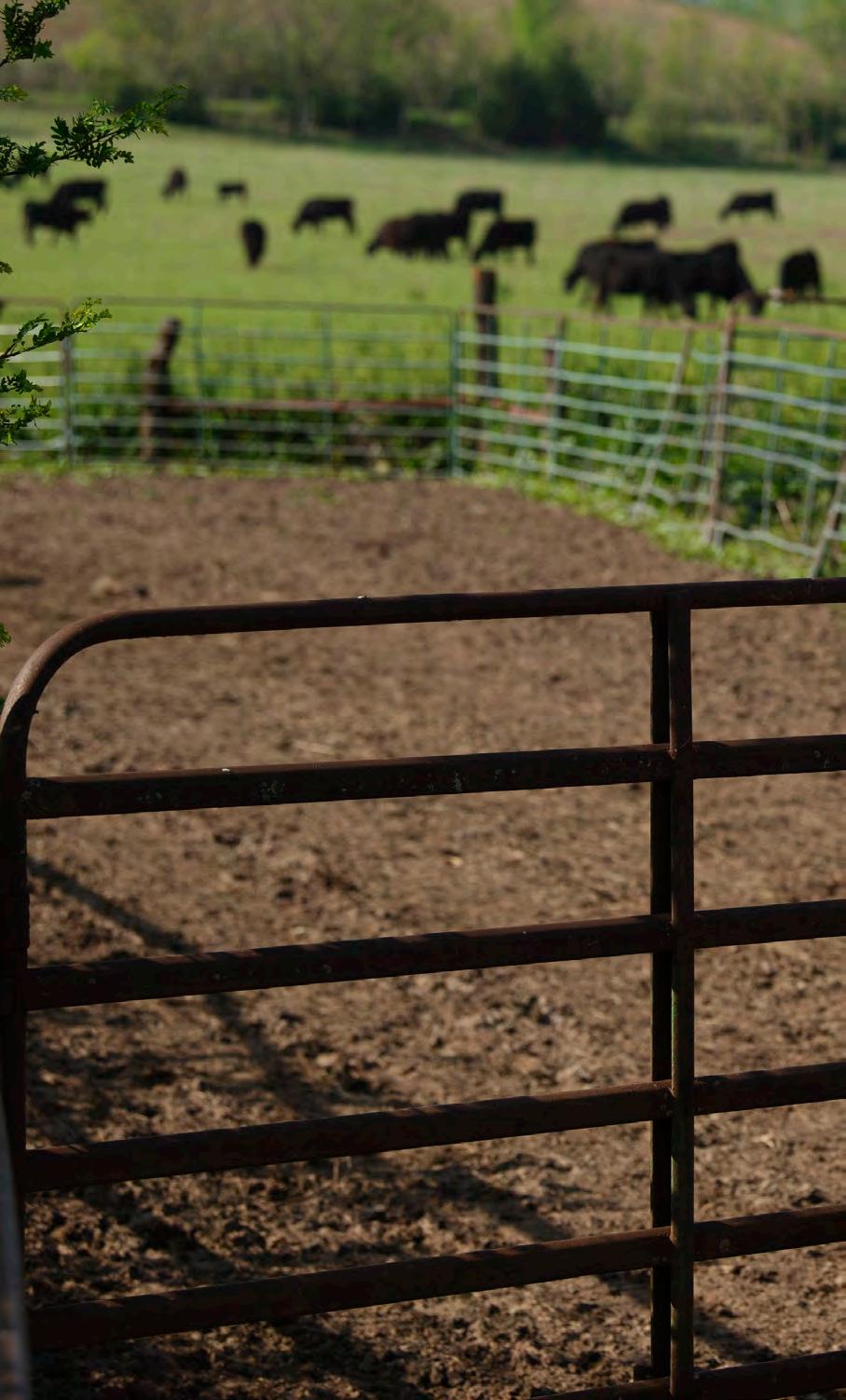
“I did pretty well [in rodeos],” he said. “I’d earn enough money that I didn’t have to work a regular job for a long time. But at that time, you could get seven plays on a jukebox for 25 cents. Expenses weren’t very much and it just kept me going.”
But, Hoy soon realized he would need a real job and went into teaching in El Dorado.
“I realized, ‘I’m gonna run out of money. I better get a job,’” he said with a laugh. “I ended up teaching eighth



graders in El Dorado Junior High for two years, between 1963 - 65. I realized I did not want to spend my life in the eighth grade,” Hoy said. “Those kids drove me crazy. I have great respect for people who can teach eighth graders and do it well and enjoy it.”
In 1965, Hoy married Cathy Thompson of Chanute. The couple moved to Missouri, where Hoy pursued his PhD at the University of Missouri-Columbia.
“I have great memories of Missouri,” he said. “Our daughter [Farrell Hoy Jenab] was born our second year there.”
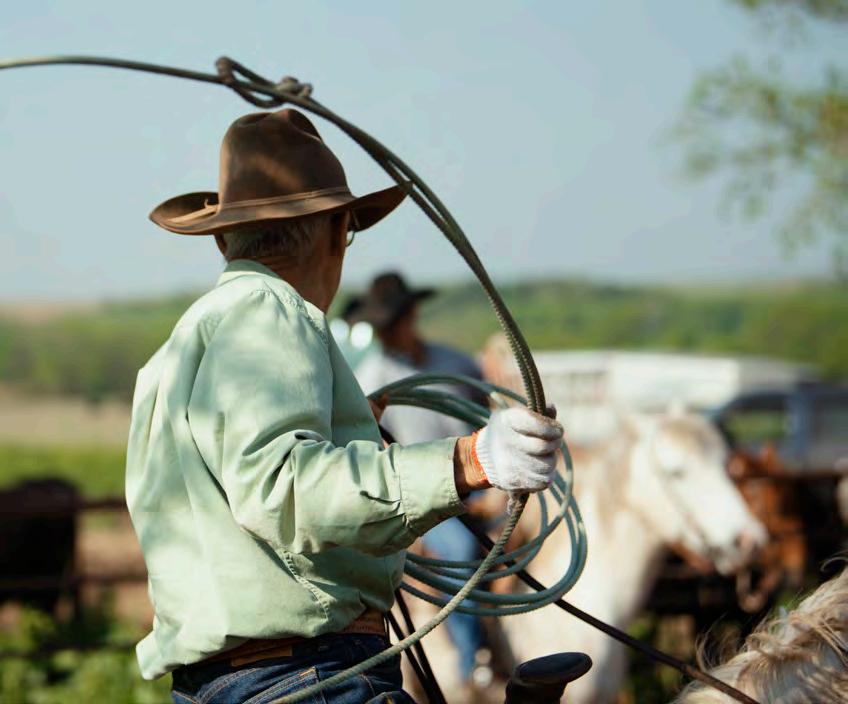
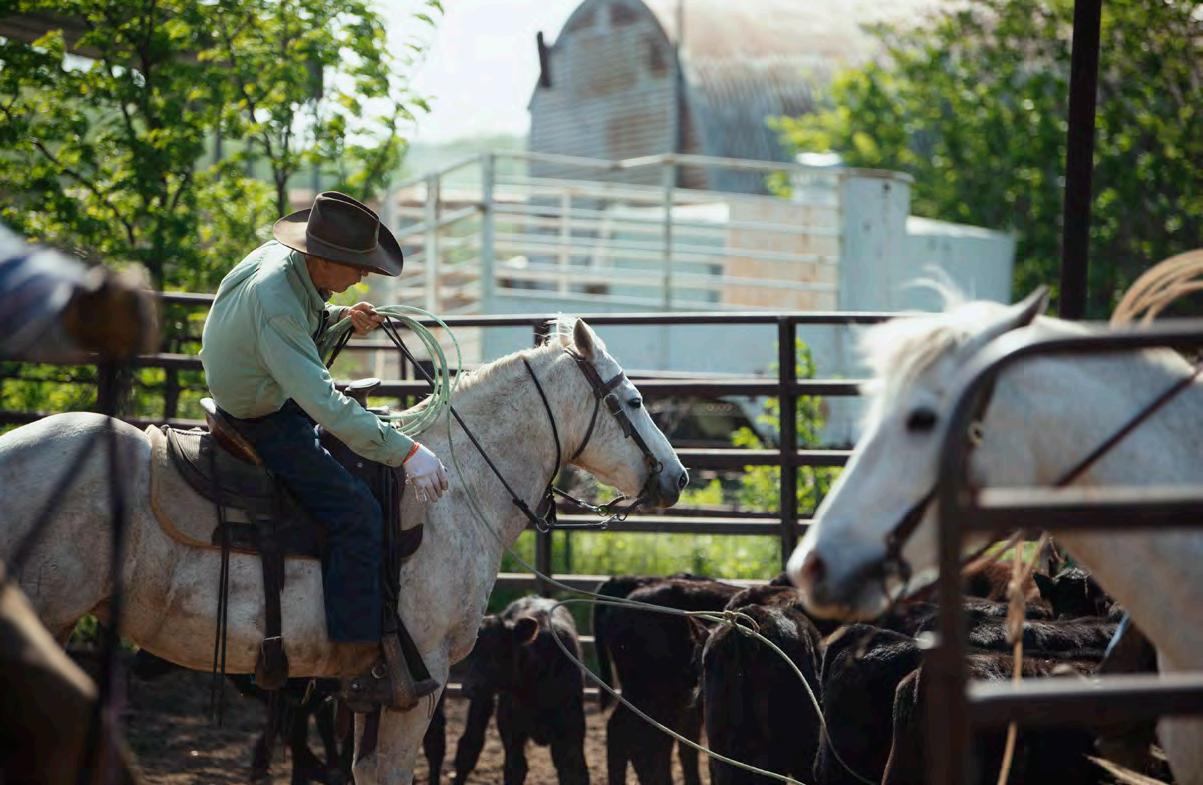

Farrell Jenab is now the director of faculty development at Johnson County Community College. Another child, Josh Hoy, would come later. He runs the Flying W Ranch in Cedar Point, Chase County, with his wife Gwen and their daughter Josie.

Though retired from teaching, Jim Hoy is still researching and writing about the American West, the cowboy.
“The cowboy has become our national hero,” he said. “The cowboy arose from the dust of the old Chisholm Trail, because these herders, the drovers, are men and boys primarily working livestock from the back of a horse.”

The cowboy was popularized in the 19th and 20th centuries, by figures like Buffalo Bill Cody. Later, the cowboy appeared in westerns starring the likes of John Wayne, Peter Fonda, Gregory Peck.
“The cowboy hero is not always a cowboy,” Hoy said. “Look at ‘Star Wars’ and Han Solo. He’s a cowboy hero. Look at his companion, like the Lone Ranger and Tonto. It’s like the Cisco Kid and Roy Rogers.”

The combination of the rule of law and the rights of an individual to act according to his conscience, Hoy said, is what has kept the cowboy mythos alive. And that has kept Hoy writing all these years.
And, it’s what earned him accolades like the Chester A. Reynolds Award, as a champion of the American West.
80,000 square feet of disc golf discs, bags, baskets, and apparel fill Dynamic Discs new headquarters at 840 Overlander. Dynamic Discs owner Jeremy Rusco couldn’t be happier with their new home.

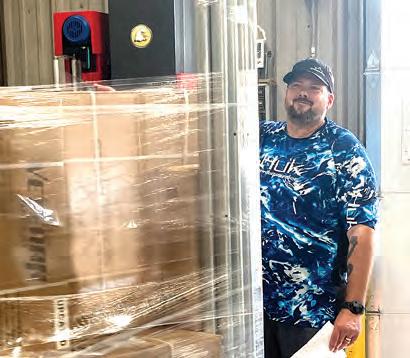

“Being able to buy the Detroit Reman facility came at a great time for us,” Rusco said. “We were out of space and were looking for a building when this came up for sale. The pandemic exploded the popularity of disc golf and was forcing us to scale up and grow quickly.”
As Rusco envisioned the new headquarters he wanted it to be more than a warehouse facility; he wanted it to be a destination.
“Emporia is the Disc Golf Capital of The World and we wanted our new facility to be part of that destination experience,” Rusco said.
So during the year-long remodel of the headquarters they added a 900 sq. foot entertainment area for the DD staff that includes a full bar, a waterfall in the lobby, an outdoor deck, a kitchen, a 9-hole disc golf course and a disc golf museum with rotating exhibits. They even have a room set up to start their own beer brewing production.

The new facility also includes a state-of-the-art media studio, Amazon fulfillment area, custom disc stamping area, online auction studio, wholesale operation fulfillment, and more.
“Having real loading docks has made it so much easier to move products around and the high ceilings allows us to stack products much higher. Both of those have been real game changers for us,” Rusco said.
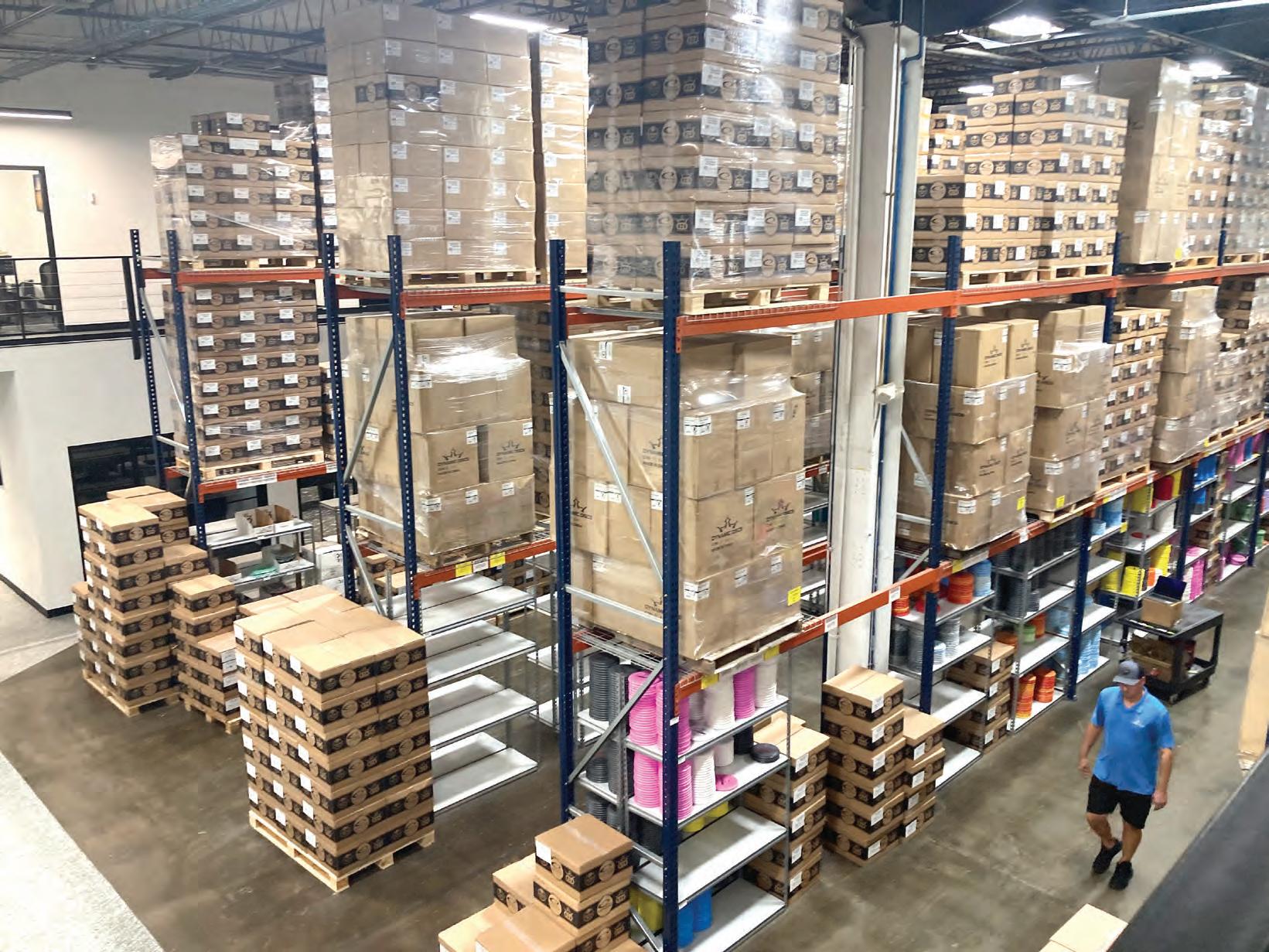
Dynamic Discs has doubled its staff from 40 to 80 employees in two years and needed more office space.

“The office build-out worked perfectly with its centralized location for the staff. We finally had enough room to build out appropriate offices for everyone,” Rusco said. “One of the coolest things about our organization is the fact that while we are in an era where people have been not too eager to come back to work, our staff has been here excited to come back and work onsite after the pandemic.”
Despite all the positives of the new space, Rusco said there is one problem: they are already out of space.
Every square inch of the 80,000 square feet has been filled and Rusco is having to rent warehouse space down the road. Filling it up came much sooner than he expected.
“Every building we have gotten into has been way bigger than we needed. I remember stepping into our previous 20,000 sq feet facility thinking this is more space than we will ever need. But we quickly outgrew it.” Rusco said “When we stepped into this building I thought the same thing, but we have already filled it up and it doesn’t seem that big anymore. It’s funny how your perspective changes as things evolve and change.”
Rusco isn’t too concerned about the space, though. He sees it more as an opportunity than a problem.
“Being out of space means there are more good things to come,” he said. “More space will be needed, more employees will be hired, and that means disc golf is growing and so are we.”







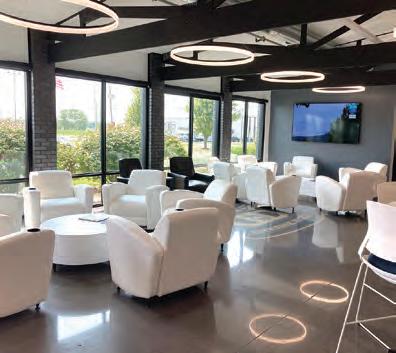










 By Ryann Brooks Cream
By Ryann Brooks Cream


The Reed family prepares to pass on beloved local business to another generation
Royalty
Not many people can say they have grown up in an ice cream shop.
If you’re a Reed, it’s just part of the family business. The Reed family is moving into its third generation of ownership of Dairy Queen, located at 1710 W. Sixth Ave.

“It’s hilarious to say, ‘I literally grew up in a Dairy Queen,’” current owner Russell Reed said with a laugh. “I’m 60, so I’ve personally been in the Dairy Queen business for about 40 years.”


Emporia’s Dairy Queen opened in 1956. Its first owners were Jerry and Marie Icenhower. Back in those days, the ice cream portion of the business shut down for the winter. To bolster finances, Russell said the Icenhowers built a walk-up restaurant called Jerry’s Carryout.

“To this day people still tell me they were the best hamburgers that they have ever tasted,” Russell said. In the 1960s, the Icenhowers added a new roof to the building, making the store look more like a dairy barn. The inside order area was renovated around the same time, and looks virtually identical today as it did 60 years ago.
The drive-thru was added by accident; Marie Icenhower, busy attending to children in the backseat, drove her
little sedan directly into the building. It exists in the same spot to this day.
Russell’s parents, the late Larry and Sharon Reed, purchased the Emporia Dairy Queen from the Icenhowers in 1982. The Reeds were familiar with the business,
having already run a location in Wichita and Fort Scott for about 10 years. From Madison originally, the family wanted to be closer to the Flint Hills and jumped at the chance to return to an already established business.


And Larry had spent time visiting that very location during college, talking with the Icenhowers about the Dairy Queen business.
Russell said it was a challenging endeavor. The Emporia store needed a


“complete remodel,” and in the years before the Blizzard Treat, it was hard to finance. So, the early years were tough, but Russell said his parents always paid close attention to their customers and “always parallelled QVSC — quality, value, service, and cleanliness.”
Russell, who began working for his parents in Emporia in 1982, had long decided to remain in the family business. He purchased the business from his parents in 2007. It wasn’t a hard decision to make.

“A lot of places you go to work — the tire shop, the insurance office, or anything like that — and people have to go there. They have to buy those, even if they don’t want to,” Russell said. “But when people come here? They’ve got a smile on their face. They want to come here. They want to buy ice cream. I mean, you’re a hero every time somebody pulls through.”
Russell said it’s the best feeling in the world to put a smile on someone’s face at work.
“They may not be having the best day before they came here but they’re happy when they show up,” he said. “It means the world for us and our staff to put a smile on their face and make them happy.”
Above the window in the drive-thru, painting on the wall is one simple set of instructions: “Please smile.”
“We strive really hard to hire the absolute best in people that we can hire, because that’s how we compete — by being friendly and nice,” Russell said.
Over the years, Dairy Queen has served as the first job for thousands of young people in the community. Each new hire




learns the ropes the same way: through hands-on experience. Russell said he assures all the greenhorns that no mistakes they make have not already been made before.
That includes coming into broken freezers and a cabinet full of melted cakes.

“There’s nothing you can do that we haven’t already done,” he said with a laugh. “We’ve already done it.”
Now Russell’s son, Owen, is preparing to take the reins from his father in the next few years. Owen, like his father, grew up in the business and has been working at his dad’s store since he was just a kid. Owen, now a graduate of Emporia State University, has been a familiar

fixture to regular customers over the years.
“It’s what I know how to do,” Owen explained. “I was already fully immersed in it and it’s the same stuff. It changes some here and there, but it’s a lot of the same things day to day. I’m working with all these kids and the customers. I have a good relationship with customers. You know, you’re kind of a celebrity around town.”
Russell, who had hoped his son would take over one day, is proud to see that becoming a reality and see the business continue for another generation.
“We’ve been here 75 years now, so it looks like we’re gonna make it,” Russell said.






Tucked away in the heart of rural Lyon County, sits a destination that harkens back to a simpler, sweeter time.

It’s easy to miss if you don’t know what you’re looking for most days of the week, but for those lucky enough to have heard about the Early Bird Farm Stand, it’s worth an early drive on a Saturday morning.






The Early Bird Farm Stand is a self-serve honor system family farm stand offering a variety of baked goods and produce. The stand, run by Asa and Casey Phillips, is located on their rural property, about four miles west of Hartford on Road 110. The venture started a couple of years ago, after Casey left her job as a counselor at Timmerman Elementary School to be a full-time stay-at-home mom to Jolene and Tripp.
Her husband, Asa, is a farmer and rancher by trade.
“Your days get so full, just taking care of littles, because we have two, and at the time we had two under the age of 2,” she said. “It just started with doing things like getting the KitchenAid out and the kids would come running as quick as
they could, because they wanted to help me make cookies. They knew exactly what I was doing with that mixer.”
Casey said the Phillips clan filled their days that way — baking cookies and pies and anything else that struck her fancy. They would take extras to friends, family and neighbors. Two years into that endeavor, Casey said she started to feel like maybe this was something she could do.


“For some reason, I kept thinking about this quote, ‘Grow where you are planted.’ I kept thinking, ‘OK, where am I planted? I’m planted at home with our kids. How can I grow right here where I am?’ And I think the idea slowly came together that way,” she said.
Aside from their mutual love for baking, the Phillips kids enjoy
helping out in the garden. Or, more accurately, playing in the dirt and occasionally picking produce along with mom and dad.
So, the first iteration of the Early Bird Farm Stand took shape in April 2021 with a small wooden shed built by Asa that was run with electricity. The family took the name from somewhere very special — Casey’s great-grandmother.



“Early Bird was the name of my mom’s granny, who she was very close to,” she said. “The name is in honor of her.”
And, the name has proved to be very fitting.
“We always tell people, ‘the early bird gets the rolls.’ You got to get to the farm stand early to get the warmest, freshest rolls,” Casey said.
The family officially opened the stand in May 2021, offering “Slowdown Saturdays,” the first Saturday of the month.
“It was so neat how neighbors were showing up and just almost turning it into coffee time, you know because I tell everyone that comes out to visit that it’s almost like bringing the front porch back,” Casey said. “I didn’t have expectations of anything like that, but it’s just the sense of community it’s building. It’s just this front porch feel.”
That first little building lasted a full summer and fall season before a December windstorm flipped it over and ripped the roof off. The Phillips took it more as a sign to expand than anything else.
“We kind of knew we were going to have to do something bigger,” Casey said. “So, that was kind of like our sign.”
They upgraded to an Amish shed that Asa had purchased even before the couple got married to use for storage. They cleaned it out and gave it an upgrade, turning it into a cute little walk-in farm stand complete with heat and air conditioning. Casey said this allows her to keep the stand open longer throughout the year, rather than banking on the weather.

Now the stand is open each Saturday morning, with an everchanging selection of goodies every week.
Casey likes to experiment with new recipes and incorporate new flavors and items into the stand. Sometimes neighbors and friends will bring her things like fresh peaches, which translates into a special treat one week. When we talked to Casey for this story, she was just getting into the fall spirit which meant lots of pumpkininspired goodies in the works.
rhyme or reason,” she said with
outside with a cashbox secured and people can leave cash or checks or even use Venmo.
“It’s worked out really great so far and there’s been a few times when I’m out there if somebody needs change, I’ll run in and grab change really quickly,” Casey said. “But there’s been times we haven’t been there for that and somebody will just say like, ‘We overpaid $2, but keep it.’ It’s a way of
the fall flavors,” she said. “We’ll do a pumpkin sweet roll and a caramel apple sweet roll, along with our regular cinnamon rolls.”
For the winter, Casey likes to play around with traditional holiday flavors like peppermint or egg nog. She’s done cookies and scones and more.

the Emporia Farmers Market. She also works with a local coffee roaster.
When it comes to the honor system, Casey said there haven’t been any issues. It’s actually pretty common, she said, for farm stands to run that way. There’s a lockbox
showing people that we trust them to come and shop at our farm stand and do the right thing.”
Casey keeps an inventory sheet out in the farm stand and asks people to tally up what they have purchased and how they are paying. It’s a way for them to keep track of what’s selling and also keep documentation for Asa’s wholesale license.
When it comes to the future, Casey would love to see the Early Bird Farm Stand continue to grow.


“It’s been completely different in a good way,” Casey said of the farm stand. “It’s just grown in ways that I didn’t even expect it to. I’m excited to see what kind of naturally grows from it.”











With its grand limestone facade, and oak window casings and doors, The Emporia Gazette building has carved an impressive figure against the backdrop of downtown Emporia for more than 120 years.




Local couple have big plans for iconic downtown building
Today, Rick and Colleen Mitchell are working to breathe new life into the building. The couple purchased the longtime home of The Emporia Gazette in January 2022, ushering in a new chapter for both the newspaper and the community. Their plans include renovating the upper floor into living spaces, and relocating the Mitchell-Markowitz business to the south office space — and possibly a restaurant in the former pressroom.
The timeline for at least a portion of the renovations moves through the end of 2023.
“In the beginning of 2024, you’ll see Mitchell-Markowitz on the southside when you come in, all the way back to the map,” Colleen said.
The world map had been a longstanding feature of The Gazette’s former newsroom, evidenced by the inclusion of the U.S.S.R.. Colleen said the map, which has deteriorated over the years, will be preserved as much as possible.
“There may be some opportunities for some living quarters in the back,” Colleen added. “We’ve talked a lot about a food hall or restaurant-type concept and we’ve been developing a lot with our team of architects, designers and of course, Mitchell-Markowitz will be the contractor. We’re trying to maintain the integrity of the


building, the history of the building, with a flexible use for today.”


Rick said he was drawn in by the building’s impressive architecture, the building’s solid brickwork and creaky oak and parquet floors. He saw potential for the large open office space, and the opportunity for living spaces on the second floor.


“I’ve always admired the building,” Rick, a contractor and owner at Mitchell-Markowitz Construction, said. “I just kept looking at it and I just couldn't resist it. I couldn’t resist the historical significance of the building.”

Rick has an eye for architecture, having been involved in some of Emporia’s biggest historic renovation projects, such as the Kenyon Hall restoration at the former College of Emporia campus. His latest big project is a mixed development building in the 700 block of Commercial Street, bringing more high-end lofts to the downtown area.
Because The Gazette building has been maintained over the years, Rick said the thought of it falling into disrepair was never a concern.


“I was never concerned about it not being taken care of or falling apart, because it has been [taken care of],” Rick said. “The mixed use I saw right off, with the opportunity to do some housing upstairs.


I wasn’t really sure of the downstairs, but the press room is such a cool space. William Lindsay White’s office; to me, you don’t really have to worry about those spaces. Something good will happen there because it’s such a cool space.”
“It is a grand building in Emporia and it does have all the classic ‘big city old building’ kind of things that make it fun, too,” Colleen agreed.
She is heavily invested in the project, which is nothing new. She often partners with her husband on renovation projects, bringing her eclectic style into the mix. Colleen said many of the grand historic features will remain throughout the renovation process.
“We really love mid-century modern kind of things, in that I love the stock and brick and metal that with a pop of modern color or funky furnishings,” Colleen said. “Chris [Walker] and I have had some conversations about what kinds of

things we could use that belong to the White family on permanent loan.”
The Mitchells said it’s important to them to celebrate that history. The building itself will always be called The Gazette building.
“We’re not changing any of that,” Colleen added. “Most of those [historical] elements will stay in place because the structure is so good. They’re looking at things down deep — fire lines and plumbing — and once you start operating in a new way, you want to make sure those things are updated, so you don’t have problems after its finished out.”
The goal, Colleen said, is to bring the building back into its former glory.
“We’re not going to change a lot of interior. We love the brick, we love the exposed elements,” she said.


For Gazette publisher Chris Walker, who had approached the Mitchells about purchasing the building initially, it’s both bittersweet and exciting to see the building taking on new life.
“It’s been our home for over a century and was such a part of the Gazette’s history,” Walker said. “We really hoped the buyer of the building would be able to breathe new life into it while maintaining the historic integrity of the space.”

“We found the perfect buyers in the Mitchells.”
“Rick and Colleen were our first picks to own the building and glad it all came together,” Walker said. “It has been exciting to see the Mitchell’s work through different ideas and plans. We know when they are completed it will add new life into this historic building but also bring a vibrancy to this part of downtown.”
The article below appeared in the Gazette on Dec. 14, 1967 where William Lindsay White described a previous remodel of how the building currently looks today.

PART OF Merchant Street is blocked off. Big carved hunks of Chase County limestone lie piled along our curbing, waiting to go into The Gazette’s front. Is this to be new? Are we remodeling?? Don’t use that word. No – no flashy materials – no chrome, no plastics, no formica – will be used in our project, which is not to remodel The Gazette’s front but to restore its appearance close to the fine old building that it originally was when it went up in the year 1900, five years after my father (then a reporter on the Star) bought the struggling little paper from the late W.Y. Morgan for $3,000.00. By 1900 it was on its own feet, so he could build a home of its own.
Matching it in architecture was a project on the adjoining lots to the north, built as a joint rental venture by my father and his College of Emporia classmate the late Robert L. Jones, their tenant being the Warren Mortgage Company, then run by S.H. Warren and his brothers Marshall and Frank. Over the years The Gazette has acquired this other building (and Jake Warren’s old roll-top desk as well) and now is overflowing into it.
It is a restoration long overdue, but for reasons. For example, some time back, Emporia’s Establishment, meeting down
in Blaylock’s Café, decided to bring Emporia abreast of the Great Society at federal expense through Urban Renewal, which would also “get rid of The Gazette” (and whatever slight historic value it might have
had) by knocking it down and making its site available to a discount house as a parking lot. Plans to this end were sketched out on the table, and, on order of our City, executed by Bucher & Willis.

But something happened to this, with the result that we now feel free to go ahead with our plans for restoration (not, however, at expense to the taxpayers).
Over the years the old Mortgage Company building (after they got proud and moved out) was put to various uses. New doors were put in for sundry tenants at various periods, and the original front got horribly botched up. The buildings are now being restored so that they will look much more like the picture postcards taken back in 1900 (showing Merchant Street still an unpaved dirt road) in all of their Victorian glory (the old Queen was still alive).
If there are changes, these will be to add things which my father liked but which, back in 1900, he could not afford, such as the use of Cottonwood Falls top ledge limestone. This was the building material of the original town as its business district went up after the Civil War. A few buildings of this period still huddle near the Santa Fe tracks (the oldest part of town) built of this same sturdy native limestone, a rock identical with the travertine of which republican Rome was built, before the Emperor Augustus gave it a veneer of Carrara marble. It is a noble stone, underpinning our own prairies, but seldom used today. My father used to drive
visitors west to see the main streets of Strong City, Cottonwood Falls, and the Chase County Courthouse, all built of this native limestone, and with a craftsmanship in carving which has vanished today. This same stone from those same ledges puts lime in the bones of the cattle which graze on the Bluestem pastures.
Because The Gazette has expanded to cover three business fronts, so will its new sign be stretched along all of them. The letters carved in this native limestone stem from a design far older than the Victorian age, for they area those basic Roman Capitals inscribed on the column celebrating Emperor Trajan’s victory over the Dacians, in A.D. 107, still standing in Rome, and from which have sprung all of our modern type faces.
Yet none has ever surpassed the original in beauty and dignity, and J. Stanley Hagan, who expanded Trajan’s capitals into letters each 24 inches high for our restored front, spent a week in drawing blueprints for them to guide the stone carver. In reproducing them it was impossible for Mr. Hagan to use a ruler or compass. For not one line is exactly straight, but has a sometimes-almost-imperceptible curve. Nor is any curve quite round, but instead is a graceful parabola. Each line of each letter had to be drawn free-hand, and so is as much of a work of art as any Venus or Apollo.
Once drawn in outline on the surface of the limestone, the inside of those letters (following Mr. Hagan’s blueprints) then will be incised at a 45-degree angle from each edge, and these sloping

sides will then (following Roman custom in Trajan’s day) be covered with gold. Not one passer-by in a thousand, glancing up at that stone sheet, into which will be carved this paper’s name, will take note of all these details. But we are working, not even to please that thousandth, but only for ourselves, and because we want it right.

Inside, the flooring, nailed down in 1900, was of pine which was all my father could then afford. In 1920, when it came time to enlarge our house at 927 Exchange St., he could afford wide planks of solid Lyon County walnut for its livingroom flooring. Not in Lyon or any other Kansas county can you buy today walnut planking cut in these widths to replace the worndown pine of the Gazette’s 67-year-old floor, so we had to make do with a substitute – a wood from the jungles of Brazil called Imbuia, which has the tone of Kansas walnut but the toughness of teak, to which it is related.
For The Gazette’s front in 1900, the best my father could then afford was a dado of soft pine, scarred now by time and many peeling coats of paint. Here, following a similar design, we plan to use white oak from the Appalachians. The natural wood grain will be brought out by an oil which, wood experts tell us, must be laid on every three years so that, in our dry climate, the oak will not crack and split as did the original pine which it replaces, and so
should last (if anything does) another century.
IRON? We will keep what we have, and these are four pieces. Two are plates under our present entrance steps, which read “The Emporia Gazette” and “W.A. White, 1900.” They were cast by Horace Jones, who for years ran Emporia’s only iron foundry, and he also cast the two iron pillars which stand at either side of this front entrance.
All this fine old Emporia Welshman’s handicraft will be kept in the restored front. But the actual entrance, to serve the expanded building, must be moved a little to the north. Here a double door will be of the same stout oak, and will be opened by a pair of pulls cast in solid brass, bought for this purpose a year ago in New Delhi, India, and chosen because each brass pull is surmounted by the head of a lion (standing for Lyon County). So now you warn that solid brass needs regular polishing. We answer that all good things in life take a little upkeep. Like sterling silver. Or white shits. Or linen napkins. If the time comes when we cannot afford the elbowgrease to keep that brass sparkling, well, we can always go out of business.
So the front will be limestone, oak, iron, brass and also glass. One of my father’s joys was in the beveled panes of glass in our house at 927 Exchange St., which was built in about 1879. He carefully preserved this glass through the 1920 remodelling. Such
beveled glass lingers in the panes of many old Emporia houses. In 1900 it was deemed far too costly for any commercial building short of a saloon or a bank. Today we deem it none too good for our restoration job, so beveled plate glass it will be – the pride of that Victorian Era.
What else? Minor items. In the floor of our basement the Markowitz firm soon will be chopping a pit alongside our present 16-page press, over which will be set a second press identical in capacity. When this press is operating, workmen from Kansas City will take apart our present press and replace every moving part – a job which will take many weeks but, when it is finished, the rebuilt press will hum as smoothly as though it were fresh out of the factory, and, wined with the second, a 32-page Gazette can be poured, effortlessly, through our folder with no need for time-wasting stuffing of inserts. This should cut an hour off our delivery time – the interval it takes to extract the news from our teletypes or reporters, and lay it on your front porch.
EXCEPT FOR some shiftingabout of partitions, that is the story. All that is old but still good will be kept, from the roll-top desks to the brick fireplace in the front office which loaded with hackberry chunks, will take the chill off this Christmas as it did back in 1900. The restored (not remodelled) Gazette front will again look, on the Centennial of my father’s birth next February, almost as it did when he built it.






















If there’s one thing Ryan Balkenhol wants people to know, it’s that riding bicycles can change your life.

And, if you’re lucky enough to have him as a coach, just maybe Balkenhol can help with that, too.
Balkenhol is the man behind Coyote Composite MTB, a National Interscholastic Cycling Association youth mountain bike team centered in Emporia. The team is composed of kids in grades 6 - 12 with common goals: learn bike
skills, build friendships and help grow cycling in a supportive and inclusive space.
“Three years ago, Tina Khan [president of the Kansas NICA league] reached out and she said, ‘I want you to be a part of this,’” Balkenhol said. “She and LeLan Dains at the time had been talking about starting Kansas NICA with a handful of other folks. They kind of sought out people they
knew would be good to get something going here on the home front.”
NICA founded its interscholastic mountain biking program for studentathletes across the United States in 2009. The Kansas program was formed in 2021, growing exponentially over the course of two years with more than 140 young people competing across the state.
 By Ryann Brooks
By Ryann Brooks
past to build friendships, life and bike skills among youth.


His only motivation, really, is to get kids on bikes and to promote movement.
Twenty of them are in Emporia. All of them — including their parents — consider themselves to be part of something bigger.
A family.
“He’s doing it all for the kids,” said Darby Cochran Wilson, who has two kids on the team. “His only motivation, really, is to get kids on bikes and to promote movement. “He’s a really good coach. He’s just very patient with these kids. Gravel is huge in Emporia, but he really wanted to expand that with some other options for a different kind of biking.”



Russ Criger, whose sons Brayden and Braxton are on the team, said he was also impressed with Balkenhol’s
patience when it came to working with teenagers.
“He’s very patient with these boys,” he said. “There was the first year that I was going to practices and there was a lot of talking. The kids, they all get together and they like to goof around and talk. Ryan’s over there trying to talk and, as a dad, I just want to go over and thump them on the back of the head because they’re not shutting up. And he just stays real patient. He doesn’t get mad. He doesn’t get upset, he never yells. It just blows my mind how patient he is with them.”
 Ryan Balkenhol
Ryan Balkenhol
Balkenhol, 42, was born and raised in Emporia to Ricci and Barry Balkenhol. He spent a lot of time exploring the Flint Hills with his dad. He competed in competitive gymnastics and raced BMX bicycles.
“I got my start there and always had a love for the bicycle,” he said. “My dad, he was always riding the bike, so it just kind of stuck with me. I grew up on two wheels and transitioned to motorcycles. But I’ve always found a love for bicycles.”
But in 1996, Balkenhol’s father passed away in an accident and Balkenhol stopped riding his bike. He was 15.
“My dad and I did all that stuff together,” he said. “My life kind of fell apart. I kind of put it down and put that stuff in the closet, and walked away from it for about 20 years.”
It wasn’t until Balkenhol had kids of his own that he would come back to the bicycle.
“Bicycles are really important to me and I wanted to at least pass that knowledge onto my kids,” he said. “I picked up the bicycle again as a way to kind of get back into health, and have fun and experience things with my kids.”
“The one thing that really stood out to me stemmed from my youth, my upbringing,” Balkenhol continued. “I remembered how those friends I had were more like family. I wanted to create that culture and that mindset that really stuck with me. That’s really how we base a lot of decisions on how we structure what we’re trying to create here with Coyote Composite.”
And the youth involved with the team are taking that culture to heart, in part because they know they have a strong advocate in their corners.
“I saw wisdom,” Braden Ayer, 15, said. “He’s been doing biking his whole life and I just saw that he knew what he was doing.” Riley Neff, 15, agreed.
“As a coach, he always makes time for you so if you wanna go out and do something personally, he will make time to go do that with you,” he said. “He knows where we’re at and he knows how we can get better. He knows what we need to work on at all times.”
For 13-year-old Kolton Wyatt, Balkenhol has given him opportunities that he would not otherwise have had. Last year, Balkenhol gave up his solo slot in Unbound Gravel to ride tandem with Kolton.


Kolton, who wasn’t old enough to register on his own,
was surprised his coach would give up his own ride.
“You have to pedal in sync. We had to stop a few times because he had a hot spot on his foot and his foot was hurting him a lot,” he said. “That’s when I came in and carried the whole race.”
Joking aside, Kolton said it was an invaluable experience.
“I was glad he would do that for me, because I wouldn’t have been able to do it,” he said.
“I asked him several times, ’Are you sure?’” Tammy Wyatt, Kolton’s mother, said. “I knew Kolton would be safe, so I wasn’t worried



at all about that. [Balkenhol] sacrifices a lot for the team.”
For Balkenhol, it was an opportunity to mentor one of his athletes. Having a “fantastic ride” was just a bonus.
“It goes back to showing people what those impacts have and, I don’t know, I felt like at that time, if I was able to give him that experience he may not otherwise have I’ll take the chance and go do it,” he said. “I knew it would stick with him.
Those are the opportunities that you don’t want to miss out on. And he was giving back to me as much as I was giving to him.”
Balkenhol added further that it goes back to his overall goal of creating a culture of family in the cycling world.
“To me, it was all about [Kolton],” he said. “I was focused on his goals and his number
one goal at that time was riding 50 miles. And he was scared to do it. I told him, ‘I think you can do it.’ … That’s kind of how it came about and I wouldn’t change it for the world.”
That’s just one example that shows the type of coach Balkenhol is, according to his athletes.
“I feel like he’s a really good coach,” said 15-year-old Braxton Criger. “He can connect with you, even if you just met him. He’s really understanding of us.”
“He’s selfless,” Braxton added. “He’s there when you need him.”
“He’s not just a coach,” Braden Criger said. “He’s like an example for us.”
“As a parent, he’s not just a coach,” Marcy Neff said. “He’s had a lot of life experience that he feeds into these kids to give
left an impact on the kids on his team.
“I would have never thought anybody thought of me that way,” he said. “When you set out to do something, it doesn’t always go the way you wanted it to. Everybody always has a game plan that they want to try to follow or a path, whatever you want to call it. The goal that we’re trying to get is just to get more kids on bikes and give them opportunities that weren’t otherwise there.”
But the bond created is undeniable.
“I think, especially in the last two or three years with everything going on in the
advice on college or jobs. You know, ‘maybe it’s not a four-year college that’s right for you, but you find something that you love to do and do that.’ He’s just truly devoted to making sure these kids want to stay into cycling.”


All of them agreed that Coyote Composite MTB wouldn’t be the same experience if it weren’t for the guy at the helm.
Balkenhol said it’s “humbling” to hear how he’s
world, we’ve been creating a family bond in a place where people feel needed and feel safe. That’s important to me and I think it shows through what people are saying,” he said. “It’s a lot of work and it’s stressful and it’s tiring, but I think the determination and knowing why we’re doing this, it helps.
“We just keep pouring our hearts into everything we do. I think we can keep watering it and it will continue to grow.”













